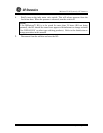
M
Millenium™ RO System by GE Osmonics
14693e - 31 Mar 03 4- 4 Routine Maintenance
4.1.2 Weekly Maintenance
1. Observe, or measure, and record the waste and product flow rates on the operation
log. Allow the water temperature to stabilize before attempting to record the
results. This will help prevent errors due to fluctuating temperature.
2. Observe, or measure, and record the feed water temperature. Systems with
blending valves have thermometers installed in the plumbing. A hand held
thermometer may also be used. The water temperature has a significant effect in
the product flow rate of the RO membrane and on the evaluation of the
membranes’ need to be cleaned.
3. Disinfect the system if needed. Refer to the disinfection procedure in this
chapter.
4.1.3 Monthly Maintenance
1. Take a product water culture to test for bacteria colony forming units count (<200
cfu/ml). Refer to the product water culture procedure in this chapter.
2. Visually inspect the pre-filter core, if you are using cartridge pre-filtration.
CAUTION:
On occasion, the pressure differential between the two pre-filter gauges will not
alter significantly, however, the pre-filter will be soiled. If the core of the pre-filter
is dirty, particulates are breaking through the pre-filter and traveling downstream
and causing damage to the pump and RO membranes. If this is the case, the pre-
filter will require more frequent replacement on a routine basis.
3. Check the pump pressure settings. The pressure should be 190 PSI ± 10 PSI, and
should not exceed 200PSI.
4. Check the maximum product pressure setting. If it is above the original set point,
reduce the pressure with the regulator inside the cabinet.
5. Perform trend analyses from the log sheets.
4.1.4 Quarterly Maintenance
1. Clean the RO Membranes. Refer to the RO membrane cleaning procedure in this
chapter.
2. Disinfect the RO machine. The RO should be disinfected after cleaning. Refer to
the membrane disinfection procedure in this chapter.
3. Verify the TDS and percent rejection readings with an independent monitoring
device every 3 months.
4. Check the quick-disconnect fittings and hoses. They should seat securely and
fluid should shut off when they are disconnected.


















